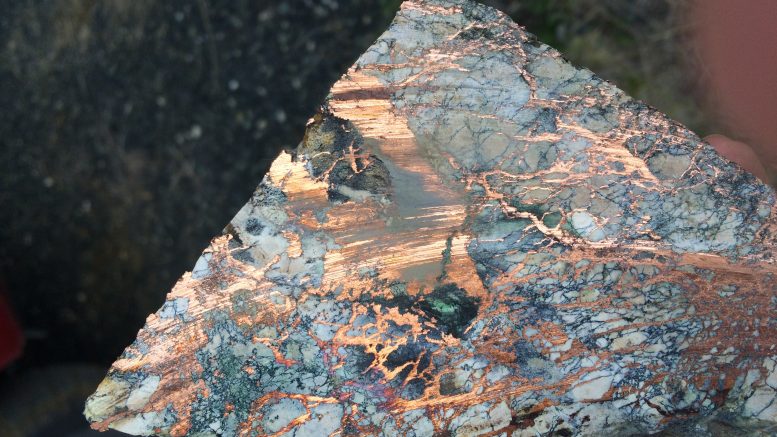For a junior exploration company with a market capitalization of $3 million, the prospect of acquiring a gold project with a past producing mine in the U.S., where Rio Tinto (NYSE: RIO; LSE: RIO) may spend up to US$30 million to earn a 70% stake, sounds almost too good to be true.
But that’s exactly what American Pacific Mining (CNSX: USGD; US-OTC: USGDF) pulled off this week in an all-share deal with privately held Madison Metals worth about $2.4 million.
“We are by no short order thrilled to have picked up this asset — and to pick it up with a joint-venture partner like Rio Tinto was a coup,” says Warwick Smith, American Pacific Mining’s founder and CEO. “It’s not very often that a company our size gets to team up with the second-largest company in the world.”
The Madison copper-gold project in Montana contains two historic underground mine developments – Madison and Broadway – and the property is 48 km from the Butte mine, which churned out 21 billion lb. copper, 715 million oz. silver, 2.9 million oz. gold and vast amounts of zinc, lead and manganese when it was in production between 1955 and 1982. “It was a colossal concentration of metal — world class in every aspect,” Eric Saderholm, a geologist and American Pacific Mining’s president and co-founder, says of the Butte mine.

An aerial view of the Madison project in Montana. Photo Credit: American Pacific Mining.

A copper rock sample from the Madison project in Montana. Photo Credit: American Pacific Mining.
Rio Tinto – through its subsidiary Kennecott Exploration – decided to earn-into the Madison project in April 2019 – and by American Pacific’s count spent $2 million on a 14-hole drill program there last year. Drill results will be released later this year.
The major apparently was intrigued by near-surface drill results that the project’s previous owner, Broadway Gold Mining, released starting in 2017, says Saderholm. Broadway drilled a fan of surface core holes that encountered multiple intrusive bodies and phases, he says, and the accompanying textures and mineralogy were strongly indicative of distal porphyry-style alteration and porphyry affinity, he explains.
“Broadway did a nice job of selecting and implementing various effective geophysical tools that helped define logical drill targets,” Saderholm says, “and these responses may indicate massive sulphide, skarn or porphyry style minerals.”
Highlights from Broadway’s drill programs include 24.5 grams gold per tonne over 30 metres from a depth of 8 metres, including 68.6 grams gold per tonne over 5 metres; 41.7 grams gold per tonne over 11 metres from 9 metres downhole, including 51.8 grams gold over 5 metres; and 6% copper over 5 metres from 123 metres, including 11.45% copper over 2 metres.

Inside the core shack at the Madison project. Photo Credit: American Pacific Mining.
“I believe that what Rio Tinto saw in the 2017 and 2019 campaigns excited them enough to continue exploring for the large system,” says Saderholm, who before setting up American Pacific Mining with Smith in March 2018 spent more than 12 years at Newmont (TSX: NGT; NYSE: NEM), where he served in many roles as an exploration manager in the United States.
“The high-grade mineralization at Madison, and the nature of that high grade, suggests that there is a deep-seated heat engine, or engines, and certainly favourable plumbing below,” Saderholm continues. “Rio Tinto is searching for the big deposit – the 50-year mine-life deposit. They are the experts and I believe they think they are in the right address and have clear targets to test.”
Ironically, Saderholm and Smith were interested in Madison four years ago and toured the underground mine workings in 2016. But the mine ultimately sold to Broadway Gold and management took that company public.
Broadway then refurbished parts of the Madison mine, rehabilitating underground workings to access stopes and mineralization, drilled, and brought Rio Tinto on board.
But last year, Broadway Gold decided to change direction and in early March of this year completed a reverse takeover with MindMedicine, a new psychedelics company that is developing neuro-pharmaceuticals that hold the promise of helping combat addiction and other mental health disorders. MindMedicine listed on the NEO Exchange on March 3.
As a result, Broadway shifted the Madison gold project into a privately held company, Madison Metals, and when Smith and Saderholm learned that there was a chance they could buy the asset, they jumped at the chance.
Developed between 2005 and 2011, the Madison mine generated 7,570 oz. gold and 3.02 million lb. copper from bulk samples totalling 17,965 tonnes. Another historic mine on the property, Broadway, produced 144,000 oz. gold at an average grade of 9 grams gold per tonne from 1.8 km of underground workings to depths of around 230 metres, between 1880 and 1950.

The Madison project in Montana at dusk. Photo Credit: American Pacific Mining.
The Broadway shaft and facility are located 300 meters from the Madison portal. The mineralization appears connected at depth, but they are considered separate at this time since none of the workings link up together.
Smith says Rio Tinto plans to drill another 14 holes at the Madison project this year.
“We’re going to have about US$4 million worth of drilling to release in 2020, which is pretty fantastic for a company of our size,” he says. “If they see what they like, our risk-to-reward ratio is incredibly good.”
News of the acquisition sent American Pacific Mining’s shares up 18.5% to 16¢. Over the last year, the junior’s shares have traded in a range of 6¢ and 69¢. It has 21 million common shares outstanding.


Be the first to comment on "American Pacific acquires Madison with Rio Tinto as partner"